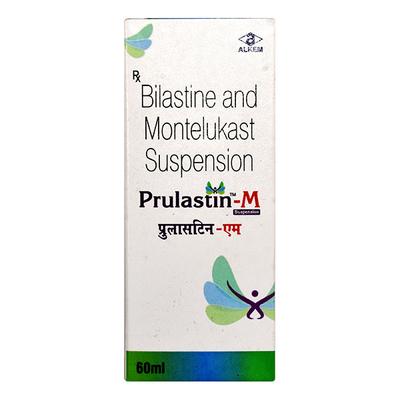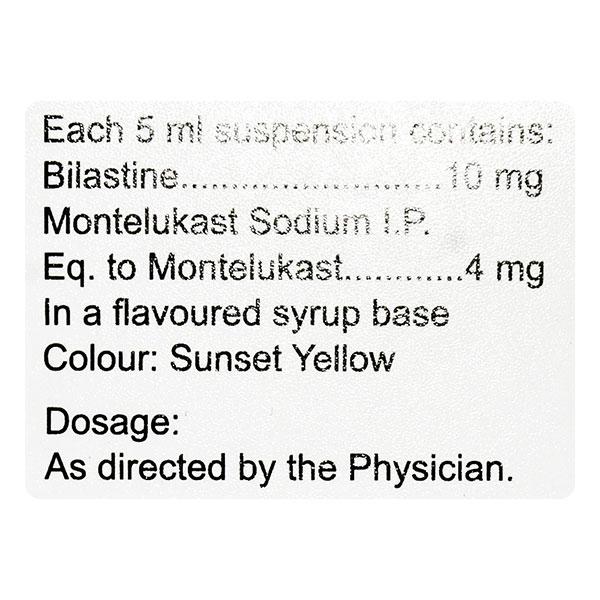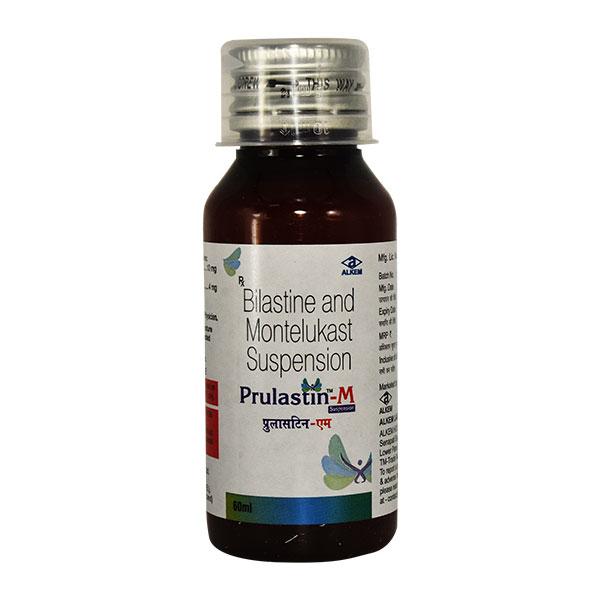

Netmeds First Membership
Quick Links
Introduction About PRULASTIN M SUSPENSION
PRULASTIN M SUSPENSION contains Bilastine and Montelukast, which belong to the group of medicines called Histamine antagonists and Leukotriene antagonists, respectively. PRULASTIN M SUSPENSION is used to manage allergic rhinitis (inflammation of the nose due to allergens) in children aged 6 to 11 years (weighing at least 20 kg).
PRULASTIN M SUSPENSION is not recommended for use in children allergic to bilastine and montelukast.
Before administering PRULASTIN M SUSPENSION, inform your doctor if your child has mental health problems, kidney problems (such as moderate/severe renal impairment), and liver problems (such as mild to moderate hepatic insufficiency).
PRULASTIN M SUSPENSION is not recommended for use in pregnant and breastfeeding women since it is used only in children (aged 6 to 11 years). It is also not recommended for use in elderly patients.
The most common side effects of administering PRULASTIN M SUSPENSION are headache, allergic conjunctivitis (eye irritation), stuffy nose, stomach pain, scaly & itchy skin, rash, and/or thirst. Consult your doctor if any of these symptoms become worse in the child.
Uses Of PRULASTIN M SUSPENSION
Used in pediatric patients:
- To manage allergic rhinitis in children aged 6 to 11 years
How PRULASTIN M SUSPENSION Works
PRULASTIN M SUSPENSION provides relief from allergic rhinitis where bilastine works by blocking histamine (chemical messenger responsible for allergy), thus managing the occurrence of allergic symptoms, and montelukast works by inhibiting the action of leukotrienes (chemicals responsible for inflammatory reactions), thus managing its occurrence and providing relief from associated symptoms of allergic rhinitis in affected children.
How to use PRULASTIN M SUSPENSION
Administer PRULASTIN M SUSPENSION in child as directed by your physician. Shake well before use. Your doctor will decide the correct dose and duration for your child depending upon the age, body weight, and disease condition.
Side Effects Of PRULASTIN M SUSPENSION
Common
- Headache
- Allergic conjunctivitis (eye irritation)
- Stuffy nose
- Stomach pain
- Hyperactivity
- Scaly and itchy skin, rash
- Thirst
Uncommon
- Dizziness, tiredness, loss of consciousness
- Diarrhea, nausea, lip swelling
- Skin inflammation, red itchy welts
- Signs of allergic reactions such as swelling of the face, lips, tongue, and/or throat, which may cause difficulty in breathing or swallowing
- Behaviour- and mood-related changes such as agitation, aggressive behaviour/hostility, depression
- Seizure
Rare
Stop administering PRULASTIN M SUSPENSION and contact your doctor immediately if your child experiences any of the following:
- Signs of allergic reactions such as swelling of the face, lips, tongue/throat, difficulty in breathing, dizziness, loss of consciousness, and/or redness of the skin
- Change in behaviour/suicidal thoughts
How To Manage Side Effects
Diarrhea
Ask the child to drink lots of fluids such as water or fruit juices so that the child is sufficiently hydrated. Do not administer any medicine to manage the condition. Consult your doctor if the diarrhea does not improve or becomes worse.
Dizziness Or Drowsiness
Ask your child to take rest and get enough sleep. Provide the child with a glass of fruit juice or water to improve dizziness. Consult your doctor if the dizziness does not improve or becomes worse.
Headache
If PRULASTIN M SUSPENSION causes headache in a child, then ask the child to take rest and drink plenty of fluids. Ask your doctor to recommend a painkiller. Headaches should usually go away after the first week of taking PRULASTIN M SUSPENSION. If the headache lasts more than a week or is severe, inform your doctor.
Nausea And Vomiting
Have the child take this medicine with or just after a meal or a snack. Let the child stick to simple meals and avoid having rich or spicy food. Consult your child’s doctor if nausea worsens.
Warning & Precautions
Pregnancy
ContraindicatedPRULASTIN M SUSPENSION is not recommended to take during pregnancy as it is intended to be used only in children.
Breastfeeding
ContraindicatedPRULASTIN M SUSPENSION is not recommended for use in breast-feeding women as it is intended to be used only in children.
Kidney
Use with CautionPRULASTIN M SUSPENSION should be used with caution in children with kidney problems (such as renal impairment) since safety and efficacy of the medicine are not established. Consult your doctor before administering the medicine to the child.
Liver
Use with CautionPRULASTIN M SUSPENSION should be used with caution in children with liver problems (such as hepatic impairment) since safety and efficacy of the medicine are not established. Consult your doctor before administering the medicine to the child.
Allergy
ContraindicatedDo not administer PRULASTIN M SUSPENSION if the child is allergic to Bilastine, Montelukast, and/or any other ingredients of this medicine.
Lungs
ContraindicatedPRULASTIN M SUSPENSION is not recommended for use in patients with lung problems such as acute asthma attacks. Consult your doctor before administering the medicine to the child.
Use In Pediatrics
ContraindicatedPRULASTIN M SUSPENSION is not recommended to use in children below 6 years of age. Consult your doctor before administering the medicine to the child.
Use In Geriatrics
ContraindicatedPRULASTIN M SUSPENSION is not recommended for use in elderly patients as it is intended to be used only in children.
Others
Before administering PRULASTIN M SUSPENSION, inform your doctor if the child has:
- Mental health problems
Interactions
A. Drug–drug interactions:
Before giving PRULASTIN M SUSPENSION to your child, inform your doctor if your child is taking any of the following medicines:
- Ketoconazole (medicine used to manage fungal infection)
- Erythromycin (medicine used to manage bacterial infection)
- Diltiazem (medicine used to manage heart diseases)
- Lorazepam (medicine used to manage anxiety)
- Cyclosporine (medicine used to manage transplanted organ rejection or reduce immune system activity)
- Ritonavir (medicine used to manage HIV)
- Phenobarbital, phenytoin (medicine used to manage epilepsy)
- Rifampicin (medicine used to manage tuberculosis)
- Gemfibrozil (medicine used to manage high levels of plasma lipid levels)
- Terfenadine (medicine used to manage allergies)
- Digoxin (medicine used to manage heart failure)
- Warfarin (medicine used to manage blood clotting)
- Paclitaxel (used to manage breast cancer, ovarian cancer, and non-small cell lung cancer)
- Rosiglitazone, repaglinide (medicines used to manage type 2 diabetes mellitus)
- Trimethoprim (medicine used to manage bladder infections)
- Non-steroidal anti-inflammatory drugs (medicines used to manage pain and inflammation) Ex. aspirin
B. Drug–Food interactions:
Do not provide grapefruit juice or other fruit juices to your child while administering PRULASTIN M SUSPENSION since it may reduce the effect of the medicine.
Overdosage:
If a child is administered too much of PRULASTIN M SUSPENSION, consult your doctor immediately or visit the nearby hospital. Symptoms of overdosage are dizziness, headache, nausea, abdominal pain, excess sleepiness, thirst, vomiting, and mood disorders.
Synopsis
| Drug | : | Bilastine, Montelukast |
| Pharmacological Category | : | Histamine antagonist, Leukotriene antagonist |
| Therapeutic Indication | : | Allergic rhinitis in children (aged 6-11 years) |
| Dosage Forms | : | Tablet, Suspension |
More Information
Storage
- Keep PRULASTIN M SUSPENSION out of reach of children.
- Do not store PRULASTIN M SUSPENSION above 30°C
FAQs About PRULASTIN M SUSPENSION
Q: What is PRULASTIN M SUSPENSION used for?
A: PRULASTIN M SUSPENSION is used to manage allergic rhinitis in children aged 6 to 11 years, which is an allergic response that occurs due to contact with an allergen such as pollen, pet hair, and/or insects. It is generally characterized by symptoms such as runny nose, sneezing, watery eyes, and/or itching in the eyes.
Q: How PRULASTIN M SUSPENSION works?
A: PRULASTIN M SUSPENSION provides relief from allergic rhinitis where bilastine works by blocking histamine (chemical messenger responsible for allergy), thus managing the occurrence of allergic symptoms, and montelukast works by inhibiting the action of leukotrienes (chemicals responsible for inflammatory reactions), thus managing its occurrence and providing relief from associated symptoms of allergic rhinitis in affected children.
Q: How to administer PRULASTIN M SUSPENSION to a child?
A: Administer PRULASTIN M SUSPENSION in child as directed by your physician. Shake well before use. Your doctor will decide the correct dose and duration for your child depending upon the age, body weight, and disease condition.
Q: What are the side effects of PRULASTIN M SUSPENSION?
A: The most common side effects of administering PRULASTIN M SUSPENSION are headache, allergic conjunctivitis (eye irritation), stuffy nose, stomach pain, scaly & itchy skin, rash, and/or thirst. Consult your doctor if any of these symptoms become worse in the child.
Q: What happens to the child if a high dose of PRULASTIN M SUSPENSION is administered?
A: If a child is administered too much of PRULASTIN M SUSPENSION, consult your doctor immediately or visit the nearby hospital. Symptoms of overdosage are dizziness, headache, nausea, abdominal pain, excess sleepiness, thirst, vomiting, and mood disorders.
Q: What are the side effects of PRULASTIN M SUSPENSION?
A: The most common side effects of administering PRULASTIN M SUSPENSION are headache, allergic conjunctivitis (eye irritation), stuffy nose, stomach pain, scaly & itchy skin, rash, and/or thirst. Consult your doctor if any of these symptoms become worse in the child.
Q: Is PRULASTIN M SUSPENSION safe during pregnancy?
A: PRULASTIN M SUSPENSION is not recommended to take during pregnancy as it is intended to be used only in children.
Q: What precautions must be taken while using PRULASTIN M SUSPENSION?
A: PRULASTIN M SUSPENSION should be used with caution in children with mental health problems, kidney problems (such as renal impairment), and liver problems (such as hepatic impairment) since the safety and efficacy of the medicine are not established. Consult your doctor before administering the medicine to the child.
Q: Who should avoid using PRULASTIN M SUSPENSION?
A: PRULASTIN M SUSPENSION is not recommended for use in patients with lung problems such as acute asthma attacks or if the child is allergic to Bilastine, Montelukast, and/or any other ingredients of this medicine. Consult your doctor before administering the medicine to the child.
Q: Is PRULASTIN M SUSPENSION safe for kids?
A: PRULASTIN M SUSPENSION is not recommended to use in children below 6 years of age. Consult your doctor before administering the medicine to the child.
References
1. Sidhartha D. Ray. Antihistamines (H1 receptor antagonists). Side Effects of Drugs Annual: A Worldwide Yearly Survey of New Data in Adverse Drug Reactions: Volume 43. First edition. 2021. Page 190.
2. KD. Tripathi. Drugs for Cough and Bronchial Asthma. Essentials of Medical Pharmacology. Seventh Edition. 2013. Page 228.
3. CiplaMed. BILAFAV M Suspension. [Revised in March 2022] [Accessed on 10th July 2024] https://www.ciplamed.com/product-index/bilafav-m-suspension
Useful Diagnostic Tests
- Complete Blood Count (CBC)/ Hemogram
- Total IGE
- Wheeze/Rhinitis Comprehensive Panel Adult
- Basic Allergy Package
- Absolute Eosinophil Count, Blood
- Allergy Comprehensive Profile
- Allergy Post Screening Profile
- Peripheral Smear Examination By Pathologist
- Full Body Checkup - Gold












